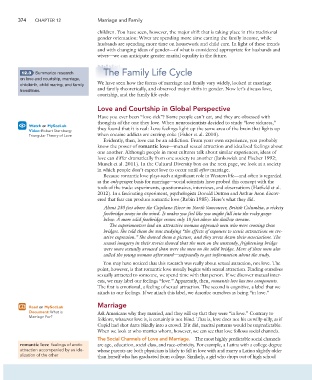Page 401 - Essencials of Sociology
P. 401
374 CHAPTER 12 Marriage and Family
children. You have seen, however, the major shift that is taking place in this traditional
gender orientation: Wives are spending more time earning the family income, while
husbands are spending more time on housework and child care. In light of these trends
and with changing ideas of gender—of what is considered appropriate for husbands and
wives—we can anticipate greater marital equality in the future.
The Family Life Cycle
Summarize research
12.3
on love and courtship, marriage,
We have seen how the forms of marriage and family vary widely, looked at marriage
childbirth, child rearing, and family
and family theoretically, and observed major shifts in gender. Now let’s discuss love,
transitions.
courtship, and the family life cycle.
Love and Courtship in Global Perspective
Have you ever been “love sick”? Some people can’t eat, and they are obsessed with
thoughts of the one they love. When neuroscientists decided to study “love sickness,”
Watch on MySocLab
Video: Robert Sternberg: they found that it is real: Love feelings light up the same area of the brain that lights up
Triangular Theory of Love when cocaine addicts are craving coke (Fisher et al. 2010).
Evidently, then, love can be an addiction. From your own experience, you probably
know the power of romantic love—mutual sexual attraction and idealized feelings about
one another. Although people in most cultures talk about similar experiences, ideas of
love can differ dramatically from one society to another (Jankowiak and Fischer 1992;
Munck et al. 2011). In the Cultural Diversity box on the next page, we look at a society
in which people don’t expect love to occur until after marriage.
Because romantic love plays such a significant role in Western life—and often is regarded
as the only proper basis for marriage—social scientists have probed this concept with the
tools of the trade: experiments, questionnaires, interviews, and observations (Hatfield et al.
2012). In a fascinating experiment, psychologists Donald Dutton and Arthur Aron discov-
ered that fear can produce romantic love (Rubin 1985). Here’s what they did.
About 230 feet above the Capilano River in North Vancouver, British Columbia, a rickety
footbridge sways in the wind. It makes you feel like you might fall into the rocky gorge
below. A more solid footbridge crosses only 10 feet above the shallow stream.
The experimenters had an attractive woman approach men who were crossing these
bridges. She told them she was studying “the effects of exposure to scenic attractions on cre-
ative expression.” She showed them a picture, and they wrote down their associations. The
sexual imagery in their stories showed that the men on the unsteady, frightening bridge
were more sexually aroused than were the men on the solid bridge. More of these men also
called the young woman afterward—supposedly to get information about the study.
You may have noticed that this research was really about sexual attraction, not love. The
point, however, is that romantic love usually begins with sexual attraction. Finding ourselves
sexually attracted to someone, we spend time with that person. If we discover mutual inter-
ests, we may label our feelings “love.” Apparently, then, romantic love has two components.
The first is emotional, a feeling of sexual attraction. The second is cognitive, a label that we
attach to our feelings. If we attach this label, we describe ourselves as being “in love.”
Marriage
Read on MySocLab
Document: What is Ask Americans why they married, and they will say that they were “in love.” Contrary to
Marriage For?
folklore, whatever love is, it certainly is not blind. That is, love does not hit us willy-nilly, as if
Cupid had shot darts blindly into a crowd. If it did, marital patterns would be unpredictable.
When we look at who marries whom, however, we can see that love follows social channels.
The Social Channels of Love and Marriage. The most highly predictable social channels
romantic love feelings of erotic are age, education, social class, and race–ethnicity. For example, a Latina with a college degree
attraction accompanied by an ide- whose parents are both physicians is likely to fall in love with and marry a Latino slightly older
alization of the other than herself who has graduated from college. Similarly, a girl who drops out of high school

